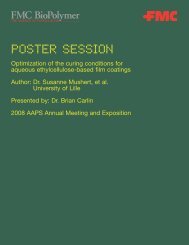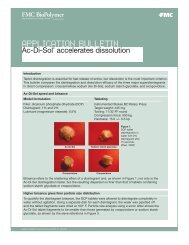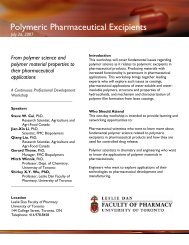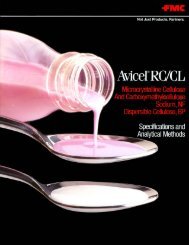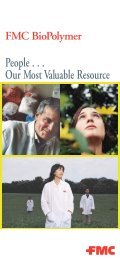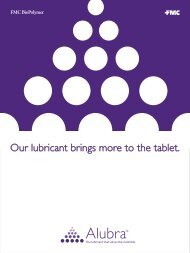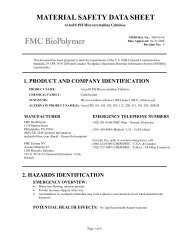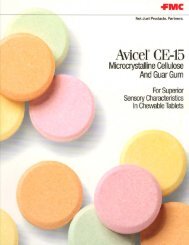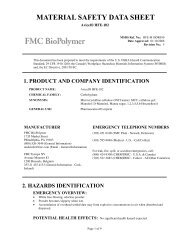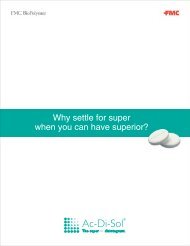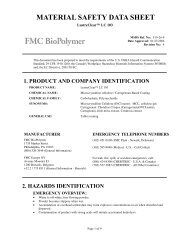StabEthycelFilmCoat HdOut.QXD - FMC BioPolymer
StabEthycelFilmCoat HdOut.QXD - FMC BioPolymer
StabEthycelFilmCoat HdOut.QXD - FMC BioPolymer
You also want an ePaper? Increase the reach of your titles
YUMPU automatically turns print PDFs into web optimized ePapers that Google loves.
The following are trademarks or service marks of<br />
<strong>FMC</strong> Corporation or its subsidiaries, which may<br />
be Registered U.S. Patent & Trademark Office and<br />
in other countries: <strong>FMC</strong> logo, Aquacoat, The Science<br />
of Formulation, and The Science of Formulation Mark.<br />
© <strong>FMC</strong> Corporation. All rights reserved.<br />
<strong>FMC</strong> <strong>BioPolymer</strong><br />
THE SCIENCE OF FORMULATION<br />
POSTER SESSION<br />
The stability of ethylcellulose film coatings<br />
containing PG alginate or carrageenan<br />
Author: Dr. Juergen Siepmann,<br />
University of Lille et al.<br />
Controlled Release Society 2007<br />
Presented by: Dr. Juergen Siepmann,<br />
University of Lille et al.<br />
www.fmcbiopolymer.com<br />
pharm_info@fmc.com<br />
2007-ECD.01.0607 Printed in USA RS
THE STABILITY OF ETHYLCELLULOSE FILM COATINGS<br />
CONTAINING PG ALGINATE OR CARRAGEENAN<br />
Susanne Muschert, 1 Florence Siepmann, 1 Bruno Leclercq, 2 Brian Carlin, 3 Juergen Siepmann 1<br />
1<br />
College of Pharmacy, JE 2491, University of Lille, 3, Rue du Prof. Laguesse, 59006 Lille, France<br />
2<br />
<strong>FMC</strong> <strong>BioPolymer</strong>, Avenue Mounier 83, 1200 Brussels, Belgium<br />
3<br />
<strong>FMC</strong> <strong>BioPolymer</strong>, US Route 1 & Plainsboro Road, Princeton, NJ 08543, USA<br />
Introduction<br />
Ethylcellulose-based film coatings offer an effective means to control drug<br />
release from solid oral dosage forms [1,2] . The use of aqueous polymer dispersions<br />
presents major advantages compared to organic solutions, including<br />
reduced processing times. However, the obtained film coatings might show<br />
further coalescence during long term storage, resulting in decreasing drug<br />
release rates. The aim of this study was to identify an easy tool to improve<br />
long term stability of polymeric film coatings from aqueous dispersions.<br />
Objectives<br />
• To identify appropriate additives for the aqueous ethylcellulose dispersion<br />
Aquacoat ® ECD, that do not cause flocculation of the coating formulation<br />
and improve the storage stability of coated pellets.<br />
• To monitor the efficiency of these novel film coatings via open long term<br />
storage trials under ambient and stress conditions.<br />
Experimental<br />
Theophylline beads were coated with an aqueous ethylcellulose dispersion<br />
(Aquacoat ECD) containing small amounts of propylene glycol alginate (PG<br />
alginate) or carrageenan in a fluidized bed. The pellets were cured for 1 or<br />
2 d at 60°C, or for 1 or 2 d at 60°C and 75% relative humidity (RH) (followed<br />
by 1 d at 60°C for drying). Drug release was measured in 0.1 M HCl as well<br />
as in phosphate buffer pH 7.4 using the USP paddle apparatus. Potential<br />
changes in the release patterns during 6 months open storage under<br />
ambient as well as stress conditions [“room temperature and ambient RH”<br />
and “40°C and 75%RH”] were monitored.<br />
Results and Discussion<br />
Figure 1: Theophylline release from pellets coated with ethylcellulose:PG alginate 90:10 blends in 0.1<br />
M HCl before (dotted curves) and after (solid curves) 6 open months storage at: (a) room temperature,<br />
and (b) 40°C and 75% RH (coating level: 20%, the curing conditions are indicated in the figures).<br />
Figure 2: Theophylline release from pellets coated with ethylcellulose:PG alginate 90:10 blends in<br />
phosphate buffer pH 7.4 before (dotted curves) and after (solid curves) 6 open months storage at: (a)<br />
room temperature, and (b) 40°C and 75% RH (coating level: 20%, the curing conditions are indicated<br />
in the figures).<br />
Figure 3: Theophylline release from pellets coated with ethylcellulose:carrageenan 90:10 blends in<br />
0.1M HCl before (dotted curves) and after (solid curves) 6 open months storage at (a) room temperature,<br />
and (b) 40°C and 75% RH (coating level: 20%, the curing conditions are indicated in the figures).<br />
Figure 4: Theophylline release from pellets coated with ethylcellulose:carrageenan 90:10 blends in<br />
phosphate buffer pH 7.4 before (dotted curves) and after (solid curves) 6 open months storage at (a)<br />
room temperature, and (b) 40°C and 75% RH (coating level: 20%, the curing conditions are indicated<br />
in the figures).<br />
Figure 5: Theophylline release from pellets coated with ethylcellulose:carrageenan 95:5 blends in 0.1M<br />
HCl before (dotted curves) and after (solid curves) 6 open months storage at (a) room temperature, and<br />
(b) 40°C and 75% RH (coating level: 20%, the curing conditions are indicated in the figures).<br />
Figure 6: Theophylline release from pellets coated with ethylcellulose: carrageenan 95:5 blends in<br />
phosphate buffer pH 7.4 before (dotted curves) and after (solid curves) 6 months storage at (a) room temperature,<br />
and (b) 40°C and 75% RH (coating level: 20%, the curing conditions are indicated in the figures).<br />
Conclusions<br />
The PG alginate and carrageenan containing ethylcellulose coatings are not<br />
as stable as the previously investigated ethylcellulose: PVA-PEG graft<br />
copolymer systems [3] , but further work is required to determine process and<br />
material contributions.<br />
References<br />
1. J.W. McGinity Aqueous Polymeric Coatings for Pharmaceutical Dosage Forms, II (1997).<br />
2. P. Schultz et al. J. Control. Release 47, 181 (1997).<br />
3. S. Muschert et al. 3rd Pharmaceutical Sciences World Meeting (PSWC 2007),<br />
Amsterdam, The Netherlands.<br />
www.fmcbiopolymer.com<br />
www.univ-lille2.fr.




